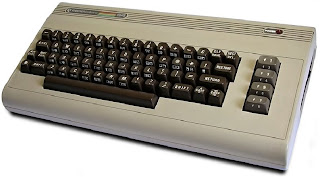 Commodore 64
Commodore 64The flagship of Commodores 8-bit fleet.
Who would have believed that the Commodore 64 (or C64) had originally been developed as a video game engine to be utilised in amusement arcades? The machine could be constantly re-programmed with newer and more exciting games without the need to change the cabinet. Change the software, keep the hardware.
This 'idea' goes some way to explain how this 8-bit micro had such good sprite capabilities coupled with fantastic music and sound. No wonder it would go on to be one of the premier classic games machines of the 1980's.
Released in August of 1982 with it's 'Arcade plans' cancelled, it was marketed to supercede the Commodore Vic 20 - and supercede the VIC it did.
At a glance, the C64 (as it became affectionately known) resembled the VIC 20. However; compared to it's ancestor, apart from the built in BASIC, it was far, far superior. It sported a large (at the time) 64KB of RAM allowing 38KB to be available to the built in BASIC V 2.0, and sound and graphics capabilities that were better than even any IBM compatible machine of the day.
The machine itself was powered by a MOS 6510 CPU running at just under 1MHZ (In the UK anyway). But let's get onto the sounds and graphics, which really set it apart from any of it's contempories.
The graphics chip the VIC-II featured 16 colors and eight hardware sprites per scanline, which could allow up to 112 sprites per PAL screen. Unprecedented! It also had in-built scrolling capabilities, and two bitmap graphics modes. Now these sort of features were the kind that turned developers on, especially games developers.
These hardware capabilities led to the smooth scrolling achieved by arcade games such as Uridium, which were to become a benchmark in home video gaming. 8 layers of graphics could also be created with the chip, which led to many classic games with interesting visual effects.
Perhaps the only down side to the sprite generation was that sometimes games characters (generated as sprites) would have a 'blocky' look to them. The sprites could not effectively generate smoothe edges, which could lead to sort of 'building block' little men on your TV screen.
Despite this shortcoming, the VIC-II graphics chip allowed the C64 to be a highly capable platform for playing arcade games in the comfort of your own home.
Character display was fine. The standard text mode featured 40 columns and like most Commodore PET models the built in font is not standard ASCII but PETSCII, an extended form of ASCII-1963.
Has anyone seen SID?
Ahh, the C64 sound. Orchestral. Soaring.
The sound chip known as 'SID' had three channels, each with its own ADSR envelope generator. With several different waveforms, ring modulation and filter capabilities, this piece of hardware was also very advanced for the time.
The SID was designed by Bob Yannes, who would later co-found synthesizer company Ensoniq. As more and more software titles were released, the music capabilities were really showcased. Quite often the game music became a hit of its own among C64 users.
Composers and programmers of game music on the C64 reached almost legendary status for their superb games soundtracks and menu music. C64'ers will hold in reverence names such as Rob Hubbard, David Whittaker, Martin Galway, Ben Daglish, Chris Hülsbeck and David Dunn.
Some of the music in the C64's classic games library is as well remembered as the game itself!
Due to the SID chip having 'only' three channel output, chords were generally played as arpeggios which let do the C64's characteristic lively sound.
There were two versions of the SID chip, the first version being the MOS Technology 6581 which was found in all of the original 'breadbox' C64s and early versions of the C64C, and the Commodore 128.
It was later replaced with the MOS Technology 8580 in 1987. The sound quality produced by the original chip is actually a little more crisp and many C64 fans still prefer its sound. The main difference between the 6581 and the 8580 was the voltage supply: the 6581 used a 12 volt supply, while the 8580 required only 9 volts. A voltage modification can be made to use a 6581 in a C64C board (which uses 9V), but that's a job for all you hardware nuts out there.
Event to this day, the SID chip has a distinctive sound which has retained a following of SID devotees. In 1999, Swedish company Elektron produced a SidStation synth module, built around the 6581 model SID chip (not using the newer 8580).
This was achieved by using remaining stocks of the chip. Several bands use these devices in their music. Now THAT is real longevity.
Apart from the technical sound and graphic capabilities, the machine was also relatively easy to program using the built in BASIC. It had the usual commands and was on a par with other 8-bit machines of the era, apart from the BBC Micro which led the way in BASIC programming.
The keyboard was also very good, typewriter style keys which were responsive to your commands.
On a visual level, the machine did look pretty cool. Nicknamed 'breadbox' and 'bullnose' in it's first incarnation (due to the shape of the case), the light brown box with the CBM logo emblazoned across the top was appealing.
The darker greyish brown keys finished the look off nicely, with the4 function keys down the right hand side of the machine giving it an air of professionalism. The design certainly evoked the right image.
As the years rolled by, more and more software titles (plenty of computer games) were released for use with the C64, and more and more C64's were sold. It became a prime buy for computer users due to it's expanding software library, and also it's compatibilty with VIC 20 hardware. Many VIC users made the step up to the C64.
All in all, it is estimated that roughly 10,000 titles were released for the C64, including development tools, office applications and many, many computer games (a lot of which are regarded as classic games).
To further make it a sound choice to the potential buyer, the hardware available to it was also very good. A C64 specific tape deck was available, which would cut any fiddling with volume and tone levels of a generic tape player when loading programs in from cassette.
Also available were peripherals including digital joysticks, analog paddles, light pens, the CBM 1351 mouse, and the C64 was could also be used with the KoalaPad, which was a graphics tablet.
Parallel printers and modems could also be attached to it - making the C64 a very good all rounder. In fact, you could probably have ran a small country with nothing more than one of these, a coffee percolator and an endless supply of garibaldis.
Due to it's large games base (with many classic arcade games and text adventures) and versatility, the C64 went on to become more popular than beer in a brewery. It had a producation run of around 11 years, from release in 1982 right through to 1993.
The popularity of this machine was only ever rivalled and equalled by one other: The ZX Spectrum. Playground arguments would regularly ensue over the merits of each machine, its games, in fact, everything. It was a classic rivalry akin to that of Borg and MacEnroe, Coe and Ovett. This was one factor that made computing in the 1980's such fun.
Will we ever have a home computer produced again that has a production run of eleven years? Nah - your modern day PC is obsolete 36 seconds after it has been released.
Along with the Apple II and the Atari XL computers, the C64 has a level of fame amongst home computer users. It has been argued that the C64 was the most prolific computing device ever manufactured. During its production run, about 30 million units were sold. To put this number in real terms, that is more than all of the Macintoshes in the world.
Everyone stand in front of the C64 altar, take a bow, and declare yourself not worthy. A fine retro computer.
We recommend trying to pick up one of these machines.
Look at computers for sale online or even locally.
If you don't want to get hold of the real hardware then try and download an emulator and
download those classic games. Alternatively you could try and play them online.
COMPUTER NAME: Commodore 64
MANUFACTURER: Commodore (CBM)
MACHINE TYPE: Home 8-Bit Micro (classic games machine)
COUNTRY OF ORIGIN: USA
RELEASE YEAR: 1982
END OF PRODUCTION: 1993
BUILT IN LANGUAGE(S): Basic
KEYBOARD: QWERTY Full stroke 66 keys with 4 function keys
CPU: 6510
SPEED: 0.985 MHz (In PAL Mode as in UK display) 1.023 MHz (In NTSC Mode as in US display)
CO-PROCESSOR: VIC II (For Video), SID (For Sound)
RAM: 64 KB
ROM: 20 KB
TEXT MODES: 40 columns x 25 lines
GRAPHIC MODES: Several but the most popular was 320 x 200
COLORS: 16 + 16 border colours
SOUND: 3 voices over 9 octaves plus 4 waveforms. The sound was output through the TV
SIZE / WEIGHT: 40.4 (W) x 21.6 (D) x 7.5 (H) cm / 1820 g
I/O PORTS: RGB (composite, chroma/luma and sound in/out), 2 Joystick ports, 1 cardridge slot, Tape interfarce (300 bps), serial, user Port, TV RF output
BUILT IN MEDIA: Cassette unit. Provision for 170 KB 5.25'' floppy disc unit (1541)
POWER SUPPLY: External power supply unit
PRICE: £229 (UK 1984)
Retro Computers and classic games




0 comments:
Post a Comment